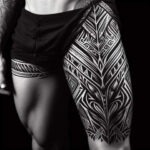Many people have Neosporin, or similar triple antibiotic ointments, in their home first-aid kits. It’s a go-to for minor cuts and scrapes, so it’s natural to wonder if Neosporin is suitable for tattoo aftercare. After all, a new tattoo is essentially an open wound.
Tattoo artist recommendations vary, with some suggesting a light application of Neosporin for a day or two, while others advise against it entirely. So, is Neosporin a good choice for your new ink, or are there better alternatives available? Let’s dive into the expert-backed answer.
Shop Tattoo Aftercare Products
The Appeal of Antibacterial Ointments for Tattoo Aftercare
Protecting your fresh tattoo from infection is a top priority. In the initial days after getting tattooed, your skin is particularly vulnerable. Antibacterial ointments like Neosporin seem like a logical solution. These ointments contain medications such as neomycin, bacitracin, and polymyxin, which are designed to combat bacteria in wounds.
Neosporin’s presence in most first-aid kits is due to its ability to create a protective barrier with antibacterial properties over minor injuries like cuts, scrapes, and burns. It’s also known to help wounds dry out and potentially scab over more quickly.
However, when it comes to tattoo aftercare, Neosporin and similar antibacterial ointments are not considered the ideal—or even a beneficial—choice by tattoo aftercare experts. The issue lies in the very properties that make them useful for minor injuries.
Alt text: A tube of Neosporin antibiotic ointment, commonly found in first aid kits, but not recommended for tattoo aftercare.
Why Neosporin Can Hinder Tattoo Healing
Antibacterial ointments, including Neosporin, have a thick, viscous consistency. This creates a strong, protective layer, which is intended to prevent bacteria from entering the wound. However, this barrier also restricts oxygen flow to the skin. Skin needs to breathe to heal efficiently, and this lack of oxygen can actually impede the tattoo healing process.
Essentially, heavy, barrier-forming products, ranging from Vaseline and Neosporin to other thick antibacterial ointments, can slow down the healing of your new tattoo. They create an occlusive environment that isn’t conducive to optimal skin regeneration after tattooing.
Read More: Can You Put Vaseline on a Tattoo?
Potential Downsides: Side Effects of Antibacterial Ointments on New Tattoos
For healthy individuals, antibacterial ointments are often unnecessary for routine wound care. The primary focus for new tattoos should be keeping the area clean, protected, and properly moisturized with appropriate products.
Furthermore, antibacterial ointments can trigger adverse reactions in some individuals. Common side effects associated with Neosporin and similar products include:
- Allergic Reactions: Some people experience allergic reactions to the antibiotics in these ointments. Symptoms can range from hives and rashes to intense itching and discomfort around the tattoo site. These allergic responses can not only delay healing but also potentially distort the tattoo ink, leading to uneven color or fading.
- Antibiotic Resistance: Overuse of antibiotics, even topical ones, can contribute to antibiotic resistance. Using antibiotics only when genuinely necessary is crucial to minimize the risk of your body becoming resistant to these medications in the future.
- Scarring and Ink Fading: Disruption of the natural healing process, potentially caused by ingredients in antibacterial ointments or allergic reactions, can increase the risk of scarring or premature fading of your tattoo’s vibrant colors.
Alt text: Close-up of a new tattoo exhibiting redness, which could be exacerbated by using inappropriate aftercare products like Neosporin.
Neosporin on Healed Tattoos: A Limited Exception
While generally discouraged for new tattoos, there’s a limited circumstance where Neosporin might be considered. If you get a minor cut or scrape on an older, fully healed tattoo, Neosporin could be used, as this is its intended purpose. However, even in this case, it should be applied sparingly in a thin layer and for a short duration.
Regardless of when you apply any product to your skin, it’s essential to watch for any signs of allergic reactions. These include swelling, unusual redness, hives, itching, or rashes. If you notice any of these symptoms, discontinue use immediately. If the issues persist or worsen, seek advice from a healthcare professional.
The Right Way to Care for a Healing Tattoo
For optimal tattoo aftercare, choose synthetic, fragrance-free products specifically formulated for new tattoos. This includes high-quality tattoo bandages like Saniderm, gentle cleansers such as Saniderm Tattoo Aftercare Foam Soap, and specialized tattoo balms like Sanibalm. These products are designed to moisturize your tattoo without creating a suffocating barrier that slows down healing. Remember to always clean your tattoo gently with clean hands before applying a thin layer of balm or lotion.
Beyond Neosporin, it’s also wise to avoid other ingredients that can hinder tattoo healing:
- Lanolin: Especially if you have wool allergies, as lanolin is derived from sheep’s wool.
- Unpurified Beeswax: Can potentially clog pores and prevent the skin from breathing.
- Dyes and Fragrances: Common irritants that can interfere with the skin’s natural healing process.
- Petroleum Jelly: Similar to Neosporin, it can suffocate the skin and slow healing.
- Alcohol: Extremely drying to the skin, which is counterproductive for healing.
- Mineral Oil: Can be irritating for some individuals or cause allergic reactions.
- Parabens, Phthalates, and Petrochemicals: These can have long-term negative effects on skin health and the environment.
Instead, look for beneficial ingredients in tattoo aftercare products such as coconut oil, shea butter, cocoa butter, sea buckthorn seed oil, and natural essential oils like lavender. These ingredients offer moisturizing and soothing properties without the drawbacks of harsh chemicals or occlusive barriers.
Alt text: A curated selection of tattoo aftercare products, including soap, balm, and bandages, representing healthier alternatives to Neosporin for tattoo healing.
In conclusion, avoid using antibiotic ointments like Neosporin on new tattoos. Prioritize tattoo-specific aftercare products to ensure your tattoo heals quickly, properly, and maintains its vibrancy for years to come.
